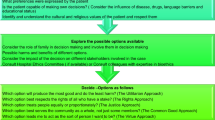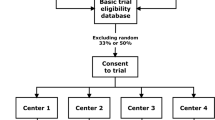Abstract
Introduction
Suicide is a global problem and accurate assessment of risk for self-harm is critical. Even morally principled clinicians can manifest bias when assessing self-harm in patients with physical disabilities such as spinal cord injury (SCI). Assessment of self-harm is an obligation for health care clinicians and overestimating or underestimating risk may undermine a patient’s trust in their care, possibly leading to less engagement, increased apathy about having an interest in living, and less adherence to healthy treatment options.
Case presentation
Introduces readers to three biases that can impact decision-making regarding a patient with a disability when assessing the patient’s risk for self-harm: (1) ineffectual bias, (2) fragile friendliness bias, and (3) catastrophe bias. These preconceptions are derived from a mix of paternalism, projection, low expectations, pity, and infantilization. In this paper, we explain how each bias can affect clinical decision-making regarding diagnosis, treatment, prognosis, and prevention for patients with SCI within a common case scenario. Readers can employ personal reflection and potential self-application when they encounter individuals with SCI in and outside clinical settings.
Discussion
Unchecked biases toward the disabled and patients with SCI can undermine ethical caregiving. Biases are habits of mind and thoughtful clinical and education interventions can improve clinical practice. The literature on health care bias with other minority groups is instructive for investigating biases related to patients with disabilities, and especially for clinicians outside of rehabilitation medicine.
Similar content being viewed by others
Log in or create a free account to read this content
Gain free access to this article, as well as selected content from this journal and more on nature.com
or
References
Thorndike EL. A constant error in psychological ratings. J Appl Psychol. 1920;4:25–9. https://doi.org/10.1037/h0071663
Albisser Schleger H, Oehninger NR, Reiter-Theil S. Avoiding bias in medical ethical decision-making. Lessons to be learnt from psychology research. Med Health Care Philos. 2011;14:155–62. https://doi.org/10.1007/s11019-010-9263-2
Zestcott CA, Blair IV, Stone J. Examining the presence, consequences, and reduction of implicit bias in health care: a narrative review. Group Process Intergroup Relat. 2016;19:528–42. https://doi.org/10.1177/1368430216642029
Smedley BD, Stith AY, Nelson AR. Unequal treatment: confronting racial and ethnic disparities in health care. Washington, DC: National Academies Press; 2003.
Blair IV, Steiner JF, Havranek EP. Unconscious (implicit) bias and health disparities: where do we go from here? Perm J. 2011;15:71–8.
Dovidio JF, Fiske ST. Under the radar: how unexamined biases in decision-making processes in clinical interactions can contribute to health care disparities. Am J Public Health. 2012;102:945–52. https://doi.org/10.2105/ajph.2011.300601
Gonzalez CM, Deno ML, Kintzer E, Marantz PR, Lypson ML, McKee MD. Patient perspectives on racial and ethnic implicit bias in clinical encounters: implications for curriculum development. Patient Educ Couns. 2018;101:1669–75. https://doi.org/10.1016/j.pec.2018.05.016
Krahn GL, Walker DK, Correa-De-Araujo R. Persons with disabilities as an unrecognized health disparity population. Am J Public Health 2015;105(Suppl 2):S198–206. https://doi.org/10.2105/AJPH.2014.302182
Olkin R. Could you hold the door for me? Including disability in diversity. Cult Divers Ethn Minor Psychol. 2002;8(2):130–7.
Devine PG, Forscher PS, Austin AJ, Cox WT. Long-term reduction in implicit race bias: a prejudice habit-breaking intervention. J Exp Soc Psychol. 2012;48:1267–78. https://doi.org/10.1016/j.jesp.2012.06.003
Suchman AL, Matthews DA. What makes the patient-doctor relationship therapeutic? Exploring the connexional dimension of medical care. Ann Intern Med. 1988;108:125–30.
Abrantes-Pais Fde N, Friedman JK, Lovallo WR, Ross ED. Psychological or physiological: why are tetraplegic patients content? Neurology. 2007;69:261–7. https://doi.org/10.1212/01.wnl.0000262763.66023.be
Devine PGPE. Advances in experimental social psychology. San Diego: Academic; 2012.
McConnell D, Hahn L, Savage A, Dube C, Park E. Suicidal ideation among adults with disability in western canada: a brief report. Community Ment Health J. 2016;52:519–26. https://doi.org/10.1007/s10597-015-9911-3
Haque OSS, Stein MA. Humanizing clinical care for patients with disabilities. In: Cohen IG, Shachar C, Silvers A, Stein MA, editors. Beyond disadvantage: disability, law, and bioethics. Cambridge: Cambridge University Press; 2020.
Hahn H. The politics of physical differences: disability and discrimination. J Soc Issues. 1988;44:39–47. https://doi.org/10.1111/j.1540-4560.1988.tb02047.x
Park JH, Faulkner J, Schaller M. Evolved disease-avoidance processes and contemporary anti-social behavior: prejudicial attitudes and avoidance of people with physical disabilities. J Nonverbal Behav. 2003;27:65–87. https://doi.org/10.1023/A:1023910408854
FitzGerald C, Hurst S. Implicit bias in healthcare professionals: a systematic review. BMC Med Ethics. 2017;18:19. https://doi.org/10.1186/s12910-017-0179-8
Gonzalez CM, Garba RJ, Liguori A, Marantz PR, McKee MD, Lypson ML. How to make or break implicit bias instruction: implications for curriculum development. Acad Med. 2018;93 (11S Association of American Medical Colleges Learn Serve Lead: Proceedings of the 57th Annual Research in Medical Education Sessions):S74–81. https://doi.org/10.1097/acm.0000000000002386.
Sabin J, Nosek BA, Greenwald A, Rivara FP. Physicians’ implicit and explicit attitudes about race by MD race, ethnicity, and gender. J Health Care Poor Underserv. 2009;20:896–913. https://doi.org/10.1353/hpu.0.0185
Hodgins G, McSherry ML, Gibbs EP, Brosco J, Harvey PD. 3.37 The Debbie Project: reducing bias toward persons with disabilities. J Am Acad Child Adolesc Psychiatry. 2019;58:S206–7.
Galli G, Lenggenhager B, Scivoletto G, Molinari M, Pazzaglia M. Don’t look at my wheelchair! The plasticity of longlasting prejudice. Med Educ. 2015;49:1239–47. https://doi.org/10.1111/medu.12834
Kripke C. Patients with disabilities: avoiding unconscious bias when discussing goals of care. Am Fam Physician. 2017;96:192–5.
Chapman EN, Kaatz A, Carnes M. Physicians and implicit bias: how doctors may unwittingly perpetuate health care disparities. J Gen Intern Med. 2013;28:1504–10. https://doi.org/10.1007/s11606-013-2441-1
Blauwet CA. I use a wheelchair. And yes, i’m your doctor. New York Times; New York: NY; 2017.
Author information
Authors and Affiliations
Corresponding author
Ethics declarations
Conflict of interest
The authors declare that they have no conflict of interest.
Additional information
Publisher’s note Springer Nature remains neutral with regard to jurisdictional claims in published maps and institutional affiliations.
Rights and permissions
About this article
Cite this article
Budd, M.A., Haque, O.S. & Stein, M.A. Biases in the evaluation of self-harm in patients with disability due to spinal cord injury. Spinal Cord Ser Cases 6, 43 (2020). https://doi.org/10.1038/s41394-020-0293-6
Received:
Revised:
Accepted:
Published:
DOI: https://doi.org/10.1038/s41394-020-0293-6



